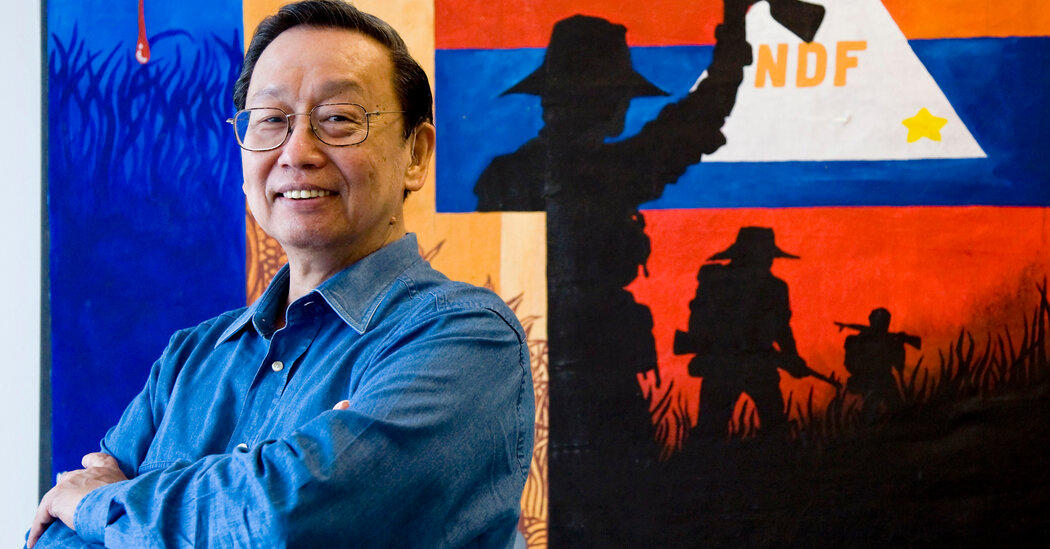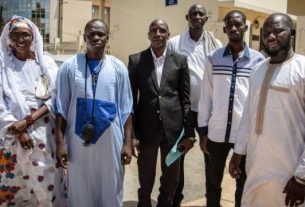[ad_1]
Jose Maria Sison, the founder of the Communist Party of the Philippines and its long-running guerrilla insurgency, died on Friday in exile in the Netherlands, where he had lived for decades. He was 83.
His death, in a hospital in Utrecht, was announced by a spokesman for the party, Marco Valbuena, who called him a “great Marxist-Leninist-Maoist thinker” and revolutionary leader. He said Mr. Sison had been hospitalized for two weeks but gave no cause of death.
A government military spokesman, Col. Medel Aguilar, said he believed that it would be hard for the party to replace Mr. Sison and that his death could further weaken the movement. “No one can match his intellect,” he said.
Mr. Sison, a left-wing organizer and poet, founded the party on Dec. 26, 1968, in a clandestine meeting with 13 of his young comrades.
Three months later, joining a rebel leader named Bernabe Buscayno, he established the movement’s armed wing, the New People’s Army, or NPA, with a small force armed in some cases with outdated weapons.
The NPA grew to a force of 25,000 armed guerrillas scattered throughout the Philippines, carrying out raids, assassinations and extortion schemes directed at landowners and becoming a source of instability to the government.
The threat of the communist insurgency was one factor in the ouster in 1986 of President Ferdinand Marcos. The United States, determined that Mr. Marcos’s unpopularity was fueling the growth of the communist opposition, withdrew its support for him.
The party’s political wing, the National Democratic Front, or NDA, has played a role in national politics, but the insurgency today has been weakened by squabbles and factional killings partly instigated by Mr. Sison. Military officials estimate that it has about 2,000 active insurgents.
Gregg Jones, author of “Red Revolution: Inside the Philippine Guerrilla Movement” (1989), said in an email, “Ultimately, Sison proved to be a tragic figure — a person of remarkable vision, zeal and stamina whose corrosive ego and ideological rigidity undermined the movement’s goals and relegated it to the margins of political life in the Philippines.”
He added: “He was stubborn and autocratic in his leadership style, and a number of longtime comrades who clashed with Sison found themselves on the receiving end of smear campaigns or assassination attempts.”
Though the movement failed to deliver on its grand vision of revolutionary change, Mr. Jones said, it spotlighted human rights abuses, poverty and government neglect, “fostering a culture of progressive activism that endures.”
Mr. Sison was arrested in 1977 and held in detention until 1986, when Corazon Aquino ousted Mr. Marcos in a peaceful popular uprising and freed political prisoners as part of a short-lived attempt at what she called national reconciliation.
In 1984, while still in detention, Mr. Sison published a book of militant poetry, “Prison and Beyond,” which, along with his other writing, won the region’s most prestigious literary award, the Southeast Asian Writers Award.
After his release he rejoined the faculty of the University of the Philippines, then shortly left the country on a wide-ranging lecture tour to promote his revolution.
His constant attacks on Mrs. Aquino’s government led her to revoke his passport while he was in the Netherlands. Putting down roots there, he continued, in his words, to “lead the revolution from abroad.”
The Netherlands formally granted him asylum in 1995. In 2002, the United States classified him as a “person supporting terrorism.”
Jose Maria Sison, widely known as Joema, was born into a well-to-do landowning family on Feb. 8, 1939, in Cabugao, Ilocos Sur. He one of nine children of Salustiano and Florentina (Canlas) Sison.
He graduated from the Cabugao, Ilocos Sur Elementary School as valedictorian in 1952 and from the renowned San Juan de Letran high school in 1956. He earned a Bachelor of Arts degree in English in 1959 from the University of the Philippines, after which he joined its faculty.
At the university he met his future wife, Juliet de Lima, who survives him. A complete list of survivors was not immediately available.
A fellow leftist at the university, Francisco Nemenzo, who later became a professor there, said that when they were students together Mr. Sison showed no signs of becoming a revolutionary leader.
“The first time I met Joe, he was more of a poet,” Mr. Nemenzo said. “I didn’t think of him as a political man. I was already leaning toward Marxism. Joe was flirting with existentialism.”
A statement by the Communist Party after Mr. Sison’s death echoed some of the Marxist jargon that he had been instilled with, saying, “The Filipino proletariat and toiling people grieve the death of their teacher and guiding light.”
In another tribute, the party called him “the greatest Filipino of the past century.”
But the Department of National Defense in the Philippines had a different perspective in a statement it issued, saying, “A new era without Jose Maria Sison dawns for the Philippines, and we will all be the better for it.”
[ad_2]
Source link



